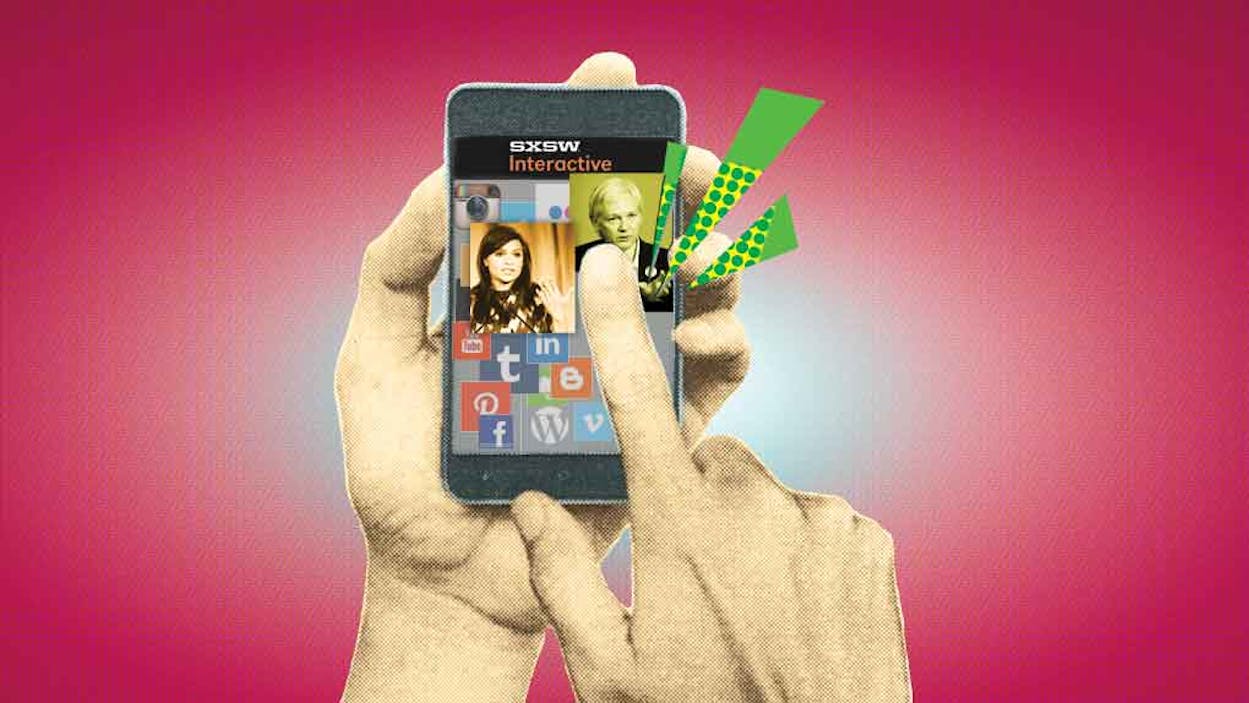The 21st annual South by Southwest Interactive Conference, which starts Friday in Austin, is on track to be the most popular edition yet of the technology oriented festival. More than 30,000 people are expected to descend upon Austin for five days of panels, parties and trade demonstrations. Attendance has nearly tripled since 2009.
For a conference known for attracting prominent names — the Facebook founder Mark Zuckerberg gave a rare onstage interview in 2008 — this year offers arguably the conference’s biggest coup: On Saturday, the founder of WikiLeaks, Julian Assange, will be interviewed by satellite from the Ecuadorean embassy in London, where he is living in exile. Yet for as much success as South by Southwest Interactive has enjoyed, the conference has had its share of growing pains. The attendance boom has been greeted with considerable criticism in the blogosphere, where many longtime conferencegoers have complained that it has become more difficult to have serendipitous meetings and exchange ideas with fellow participants. (Austin residents might add that it has also made downtown virtually impossible to navigate.)
Others have complained that by expanding its focus to include Hollywood celebrities and viral Internet sensations, the conference is in danger of drifting away from its core mission: generating ideas about
technology. Panelists this year include Hollywood celebrities like Mindy Kaling, star of “The Mindy Project,” a Fox sitcom; and the actress Rosario Dawson. The Bravo personality Andy Cohen will also speak and will again this year broadcast his nightly talk show, “Watch What Happens Live,” from Austin during the conference.
Last year an appearance by Grumpy Cat, the sourfaced feline turned Internet meme, generated considerable publicity. But when no other buzz worthy news or innovative apps emerged, some journalists — like Daniel Terdiman, who covered the conference for the techoriented website CNET — wondered whether the festival might have “jumped the shark.” “This cannot be good for SXSW,” Terdiman wrote, referring to the Grumpy Cat phenomenon.
Others were more direct. Austin Gunter, a content marketing specialist and longtime participant, wrote a muchdebated blog post in 2013 titled “I’m Calling It: SXSW Interactive Is Not a Tech Conference Anymore.”
“At first it was small enough for a core group of people to attend and manage all of the ideas, startups and products” being discussed there, Gunter said. But “what I’ve experienced in the last couple of years is that it’s less and less about the ideas, and more and more about the parties.”
According to Hugh Forrest, the conference’s longtime director, South by Southwest Interactive struggled in its early years and would probably not have survived without the revenue generated by the more successful music component of the conference. The 2007 show, at which Twitter, then an unknown app, generated a great deal of buzz among participants, proved a major turning point, Forrest said.
He also said that the conference had benefited from a larger cultural obsession with newmedia celebrities like Steve Jobs and Zuckerberg, and their “startup narratives.”
“The whole notion of ‘geek’ has changed in the culture in the last decade,” he said. “It’s gone from this pejorative putdown to ‘geeks are kind of cool.’ ”
Still, Forrest does not dismiss the criticisms. After Gunter’s blog post appeared last year, Forrest reached out to discuss the complaints.
“I think in some ways you have to work a little harder, to make the connection and meet people,” Forrest said. “But I think that one of the real strengths of the event is this concept of density. Over the course of four days, you can still meet as many people and take as many meetings as it would otherwise take you six months to do.”
Forrest demurred when asked whether the festival had lost its tech focus.
“There are people in the past who have questioned our variety of topics and say, ‘Why are you having a panel about foreign policy at a tech conference?’ We think it all connects. The future of everything — including music, movies, television — is going to be technology.”
For all the criticism, many still see the conference as far more accessible than similar gatherings, like TED and the Aspen Ideas Festival, which tend to attract a wealthier, more established clientele.
“When I started out going to SXSW in 2009, I would sit in the audience and draw the keynote speakers,” said Austin Kleon, an artist and author who is one of this year’s keynote speakers. “Slowly over time, my role evolved, and I became the one onstage. That’s part of what my talk is about this year — this idea of communal creativity and the idea that to gain a following, you first have to be a follower.”
(Of course Kleon is not oblivious to the commercial benefit of the conference. His publisher, Workman, hastened the release of his new book, “Show Your Work!,” to coincide with his South by Southwest appearance.)
All this talk about the festival becoming too big should perhaps be kept in perspective, Forrest suggested. “In some ways, I think the argument is reflective of that ageold thing ‘Austin is really cool now, but you should have been here five years ago,’ ” he said. “People have been saying that for 50 years.”






